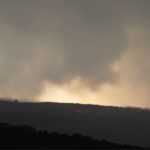As of 4pm on Wednesday, November 30, HVO reports that the Northeast Rift Zone eruption of Mauna Loa continues, with two active fissures feeding lava flows downslope.
The fissure 3 lava flows are traveling to the north, still moving toward the Daniel K. Inouye Highway (Saddle Road). Fissure 3 remains the dominant source of the largest lava flow. Advance of the largest flow slowed between 7 a.m. and 12:30 p.m. HST on November 30 to a rate of 0.02 miles per hour (24 meters per hour). As of 12:30 HST p.m. on November 30, the flow front remained about 3.6 miles from the Daniel K. Inouye Highway (Saddle Road).
The flows are reaching a relatively flat area and are beginning to slow down; as this happens, the lava flow will spread out and inflate. Forecasts indicate it may take two days for lava flows to reach the Daniel K. Inouye Highway.
Fissure 4 is still active with lava flows moving toward the northeast. A small lobe is moving to the east from fissure 4 at a slower rate than the main lobe. Volcanic gas plumes are lofting high and vertically into the atmosphere. Pele’s hair (strands of volcanic glass) is falling in the Humu‘ula Saddle area.
HVO’s seismic monitoring detects tremor (high rates of earthquakes) in the location of the currently active fissures. This indicates that magma is still being supplied, and activity is likely to continue as long as they see this signal.
There is no active lava within Moku’āweoweo caldera, and the Southwest Rift Zone is not erupting. HVO does not expect any eruptive activity outside the Northeast Rift Zone. No property is currently at risk.
Daniel K. Inouye Highway is open in both directions; however the Hawaiʻi County Police Department reports that motorists that park along Daniel K. Inouye Highway between the 16 and 31 Mile Markers will be subject to traffic citations and towing.
Wednesday’s eruption map can be accessed here: https://www.usgs.gov/media/images/november-30-2022-mauna-loa-eruption-map
DLNR Photo
